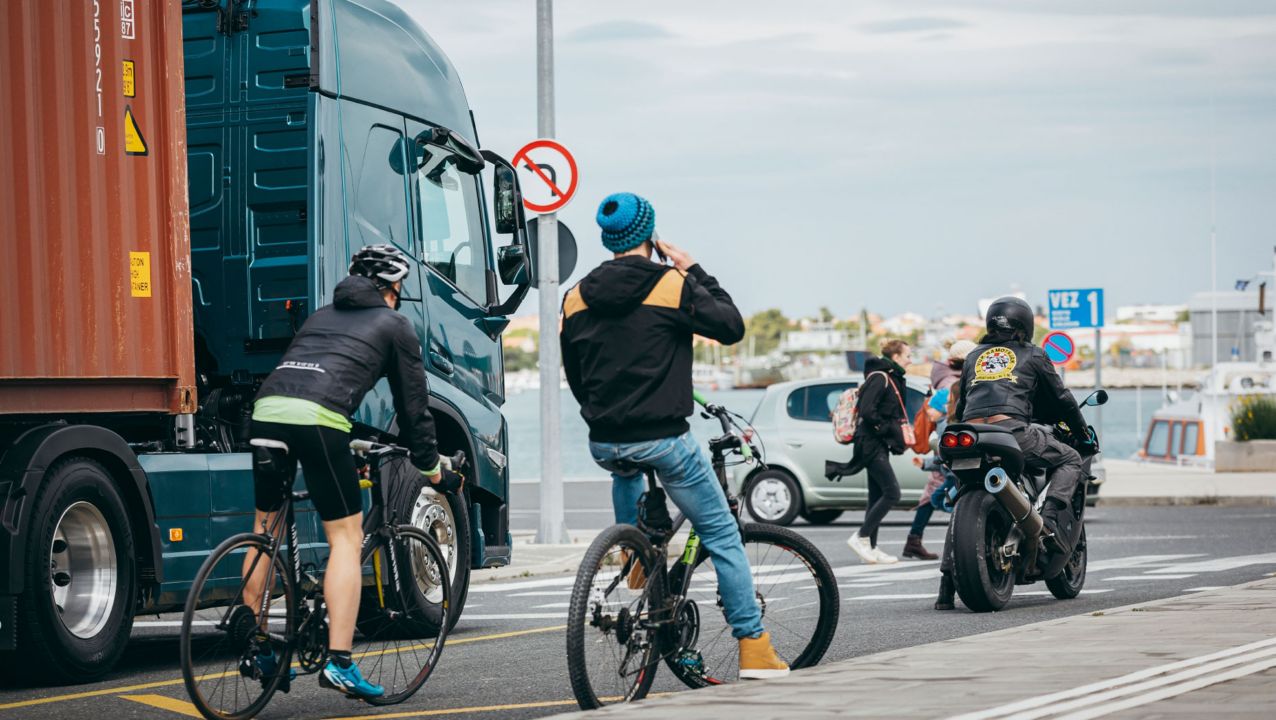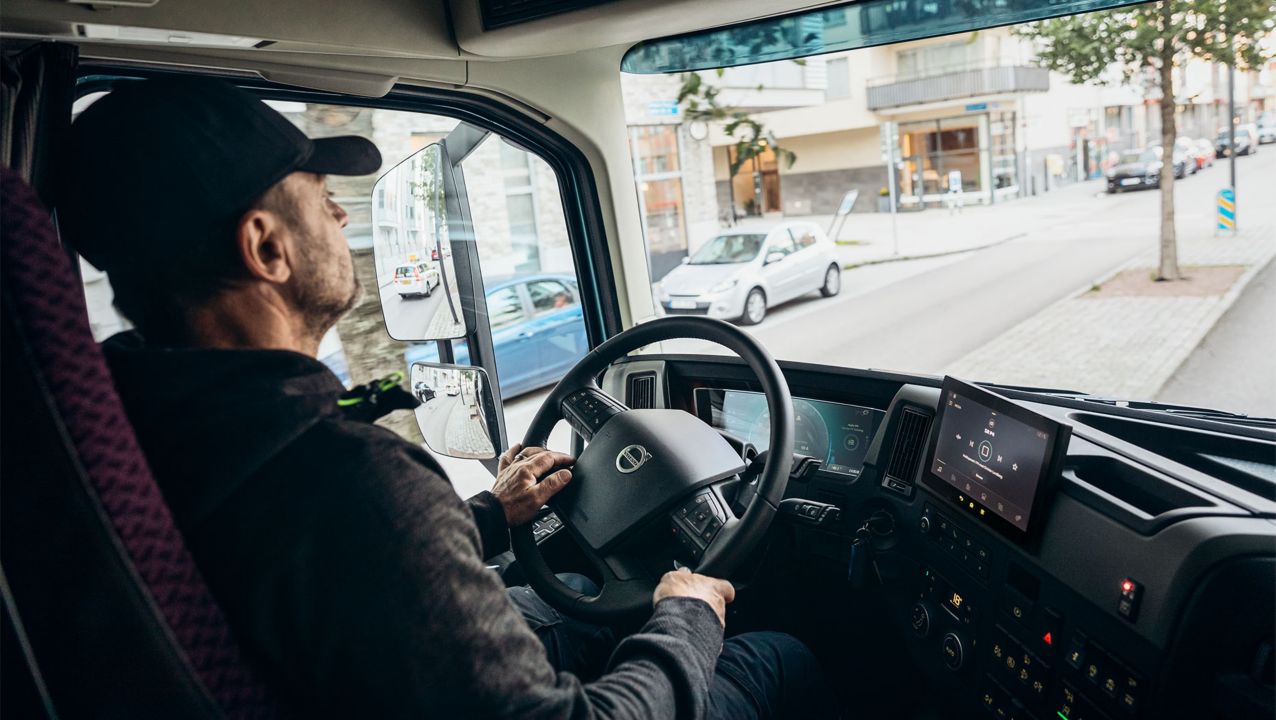Truck drivers face an increasing number of safety challenges on our busy urban roads. Why is this and how is truck safety in our growing cities being addressed?
There is no doubt that our cities are growing at an exponential rate. According to the UN, in 2018 55% of the world’s population lived in urban areas, a proportion that is expected to increase to 68% by 2050. In many cities, road infrastructure has not evolved at the same pace, causing increased congestion and difficult driving conditions for truck drivers and the increasingly diverse mix of road users all over the world.
Although little is currently known about the impact of electric scooters on traffic accidents, their recent proliferation has added another dimension to the rising number of pedestrians and cyclists on the road. There is also often a lack of awareness of truck blind spots among these types of vulnerable road users.
Smartphones can be a major distraction for all road users and compound the situation. According to the National Highway Traffic Safety Administration, distracted driving has become a significant cause of vehicle crashes in the US, with much of the distraction on the roads attributed to texting while driving. It is also common to see pedestrians – and even cyclists – moving around while listening to music or using their phone, with limited awareness of their surroundings. Studies show that almost one fifth (17%) of all pedestrians crossing a road fail to pay attention to the traffic because they are using their smartphone (Volvo Trucks 2017 Safety Report).
The increase in e-commerce and its impact on truck deliveries
The rise in e-commerce presents other safety challenges for truck drivers. These include the need to meet faster delivery times and a lack of suitable parking to be able to complete deliveries safely in an increasing range of urban locations. An annual survey conducted by the American Transportation Research Institute highlights how the e-commerce boom has intensified the issue of urban truck parking.
“Truck drivers in cities today face tough driving conditions on a daily basis: tight deadlines in many cases to get the job done, challenging road infrastructure to manoeuvre their vehicle safely, and the need to remain alert to the many risks of collisions on our congested city roads,” says Anna Wrige Berling, Traffic & Product Safety Director, Volvo Trucks.
Truck safety in cities is getting the recognition it deserves
With increased urbanisation and a more diverse mix of road users jostling for space, road safety has become high on the agenda for many city policy makers. The fact that young road users are particularly at risk – according to the World Health Organisation (WHO) the leading cause of deaths worldwide for 5-29 year olds is road traffic accidents – has also heightened the need for better urban road safety.
One of the biggest issues for truck drivers is visibility, particularly when it comes to vulnerable road users. In London, trucks are disproportionately involved in fatal collisions with this group. While trucks account for just four per cent of the overall miles driven in the capital, between 2015 and 2017, heavy goods vehicles were involved in 63 percent of fatal collisions involving cyclists and 25 per cent involving pedestrians (Transport for London). For this reason, London now has a Direct Vision Standard based on how much a driver can see directly through their cab windows. Trucks must meet the required standard in order to enter the city centre.
For Europe, the EU’s General Safety Regulation is also coming into force in 2024. Among other requirements, all trucks in Europe must have active safety technology to inform drivers if there is a vulnerable road user in the risk area at the front, side or rear of the vehicle. Direct vision standard requirements will follow in 2029. To meet the direct vision standard, the cab design, applicable to all markets, will change.
Furthermore, supplementary 360 degree camera systems – four cameras on each side of the truck to enable a complete view of the areas around the vehicle, are now cheaper and more accessible in low income nations. In higher income countries, they already have a place on many city trucks.

"Truck drivers in cities today face tough driving conditions: tight deadlines, challenging road infrastructure and the need to remain alert to the many risks of collisions on our congested city roads"
Towards zero and a more holistic approach to urban road safety
The EU’s long-term goal is to reach zero fatalities and serious injuries, known as ‘Vision Zero’, on European roads by 2050.
The United Nations also has an ambitious target – to promote the reduction of global road traffic fatalities and injuries by 50% by 2030.
Matts-Åke Belin, WHO Global Lead Decade of Action for Road Safety, says: “The outcome of truck accidents, because of their weight and size, is almost always severe. Truck safety is therefore an important part of this global target.”
WHO is also encouraging more walking and cycling to reduce environmental impact and increase health benefits. To do this, Belin says that safety has to become more integrated into how we design cities and organise mobility.
“In the past, safety was an ‘add-on’ requirement and accidents were usually attributed to human error. Now we are understanding that we have to plan for human error and take a more systemic approach to road safety. Part of this is to have a safety mindset when we design roads and use the innovative technology available to us to support truck drivers and other road users.
How trucks are changing for safer urban driving
Today, seatbelts, automated transmissions and, more recently, automated emergency braking, lane keeping support and collision avoidance technology, as well as blind spot cameras, enable a safer urban truck driving experience. The situation has improved - over the past few decades, statistics in the US and EU show that fatal accidents involving heavy vehicles have significantly decreased, despite the fact that the total number of trucks has increased.
Very soon drivers can also expect the next step – legislation that ensures the latest advances in truck active safety systems are enforced.
“It is very clear that truck driving in our cities has become increasingly challenging when it comes to safety. But with Vision Zero at the top of the agenda, truck drivers will start to see more comprehensive, mandatory safety support, not only via improved direct and indirect visibility, but also via intelligent warning systems that alert the driver if there is a collision risk. However, road safety is not just about legislation. It is about a collaborative mindset where authorities, road users and industry players must work together to reduce traffic fatalities and move towards zero,” says Anna Wrige Berling.
Read more about the safety targets for the EU and United Nations or learn everything you need to know about the upcoming General Safety Regulations (GSR). Also, here is more information on Volvo Trucks safety goals and current features.


-and-why-is-it-being-implemented?size=1280,720&scl=1)